
Raw fish or shellfish dishes include marinated raw fish (soaked in a seasoned liquid) and raw fish which is lightly cured such as gravlax, but not fish which is fully cured (fermented, pickled, smoked or otherwise preserved).

Raw fish or shellfish dishes include marinated raw fish (soaked in a seasoned liquid) and raw fish which is lightly cured such as gravlax, but not fish which is fully cured (fermented, pickled, smoked or otherwise preserved).
| Name | Image | Origin | Description |
|---|---|---|---|
| Aguachile | Mexico | Raw shrimp submerged in lime juice with cucumber, onion, and chiltepín peppers. | |
| Carpaccio |  | Italy | Very thin slices of marinated swordfish, tuna, or other large fish (a variant of the more common beef carpaccio) |
| Ceviche |  | Perú | Marinated raw fish dish |
| Crudo |  | Italy | Raw fish dressed with olive oil, sea salt, and citrus. |
| E'ia Ota | Tahiti | Raw tuna in lime and coconut milk | |
| Esqueixada |  | Catalan | Salad based on raw cod, tomato and black olives. |
| Gravlax |  | Nordic | Raw salmon, lightly cured in salt, sugar, and dill. Usually served as an appetizer, sliced thinly and accompanied by a dill and mustard sauce with bread or boiled potatoes. Made by fishermen in the Middle Ages, who salted salmon and lightly fermented it by burying it in the sand above the high-tide line. Today it is no longer fermented. Instead the salmon is "buried" in a dry marinade of salt, sugar, and dill, and cured for a few days. As the salmon cures, by the action of osmosis, the moisture turns the dry cure into a highly concentrated brine, which can be used as part of a sauce. [1] |
| Gohu Ikan | Maluku, Indonesia | Gohu Ikan could be made with tuna, skipjack, or grouper. The fish is cut into small pieces. To remove the fishy smell, the fish meat is washed repeatedly until there's no more blood left. After cleaning thoroughly, the fish meat is marinated with salt and citrus juice. The red fish meat will become a bit white. It is then mixed and stirred with sliced onion, rica (a spicy chili), and basil leaves.It has a sour flavor, spicy, with a strong aroma of basil. Roasted and coarsely grounded canary seeds can be used as a flavor enhancer. | |
| Hinava |  | Malaysia | A traditional Kadazan-Dusun dish from Sabah. Raw fish (typically firm fleshed white fish) marinated with citrus juice (usually calamansi lime), sliced shallots, julienned ginger and grated dried seed of the bambangan fruit, a species of wild mango found in Borneo. Optional additions include sliced chilli and bitter gourd. |
| Hoe |  | Korea | Raw seafood slices typically served with either soy-sauce or hot pepper paste based dipping sauce. |
| Kelaguen |  | Mariana Islands | Chamorro dish derived from the Filipino kinilaw (kilawin). It is generally made with cooked chicken, beef, or liver but can also use raw fish and other seafood. |
| Kinilaw |  | Philippines | Traditional pre-colonial marinated dish generally made with raw fish (but can also be made with other raw seafood, cooked meat, or vegetables). It is generally marinated in a local vinegar (e.g., coconut, cane, or palm vinegar); native citruses such as calamansi, dayap (key lime), and biasong; and other sour acidic fruits like bilimbi, green mangoes, and tamarind. Some regions also add coconut milk and astringent bark or fruit extracts to neutralize the fishy taste and the acidity before serving. |
| Koi pla | 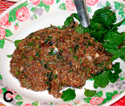 | Thailand | Minced or finely chopped raw fish in spicy salad. The most popular raw fish dish in Isan. |
| Kokoda |  | Fiji | Appetiser or side dish of any white fish. A common staple. |
| Kuai | China | Finely cut strips of raw fish or meat, which was popular and commonly eaten in the early history and dynastic times of China. According to the Book of Rites compiled between 202 BCE–220 CE, kuai consists of small thin slices or strips of raw meat, which are prepared by first thinly slicing the meat and then cutting the thin slices into strips. In modern times, the dishes are more often referred to as "raw fish slices". Commonly used fish in ancient times include carp and mandarin fish, but salmon is also used in modern times. Sauces were an essential part of kuai dishes, with green onions used for preparation of sauces in spring and mustard seed used for sauces in autumn. According to many classical texts, kuai served without sauces was deemed inedible and should be avoided. [2] | |
| Lakerda | Turkey | Pickled bonito dish eaten as a mezze in the cuisines of the former Ottoman Empire. Lakerda made from one-year-old bonito migrating through the Bosphorus is especially prized. | |
| Lap pa Larb pla | Laos Thailand | A Lao and Thai salad of raw freshwater river fish mixed with lime, cilantro, mint, scallions, roasted rice, chilis | |
| Lawa' Bale | South Sulawesi, Indonesia | Commonly associated with the Bugis people. The meal features fresh raw fish cured in vinegar and citrus juices, including bilimbi and unriped mango; as well as being spiced with grated coconut, garlic and chilies. | |
| Lomi oio |  | Hawaii | Finely minced or pureed raw fish mixed with salt. Seaweed, onions, limpets, shrimp, tomatoes, and chili are optional. |
| Namerō | 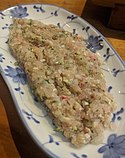 | Japan, Bōsō Peninsula | Finely chopped raw fish mixed with spices and spread thin |
| 'Ota 'ika |  | Tonga | Raw fish dish typically made with coconut cream, tomatoes, lemon and spring onions. |
| Poke | 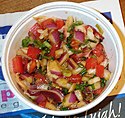 | Hawaii | Raw fish salad |
| Sashimi |  | Japan | Sliced raw seafood. Dipped in soy sauce and wasabi before eating. |
| Soused herring (maatjes) |  | Netherlands | New season herring soaked in a mild preserving liquid |
| Stroganina | 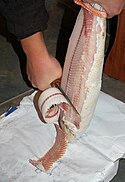 | Russia | A dish of the indigenous people of northern Arctic Siberia made from raw thin sliced frozen fish. [3] |
| Tiradito | 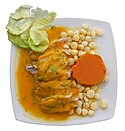 | Peru | Variant of ceviche influenced by sashimi |
| Tuna tartare |  | Disputed | Minced raw tuna dish |
| Umai | Malaysia | A closely similar dish like the hinava , popular with the Melanau community in Sarawak. | |
| Xató or Xatonada |  | Catalan | Raw cod, anchovies and tuna fish with escarole, arbequinas olives, and "romesco" sauce. |
| Yusheng |  | Disputed | Raw fish salad |

Parasites in fish are a natural occurrence and common. Though not a health concern in thoroughly cooked fish, parasites are a concern when consumers eat raw or lightly preserved fish such as sashimi, sushi, ceviche, and gravlax. The popularity of such raw fish dishes makes it important for consumers to be aware of this risk. Raw fish should be frozen to an internal temperature of −20 °C (−4 °F) for at least 7 days to kill parasites. It is important to be aware that home freezers may not be cold enough to kill parasites. [8] [9]
Traditionally, fish that live all or part of their lives in fresh water were considered unsuitable for sashimi due to the possibility of parasites (see sashimi article). Parasitic infections from freshwater fish are a serious problem in some parts of the world, particularly Southeast Asia.[ citation needed ] Fish that spend part of their life cycle in brackish or freshwater, like salmon are a particular problem. A study in Seattle, Washington showed that 100% of wild salmon had roundworm larvae capable of infecting people. In the same study farm raised salmon did not have any roundworm larvae. [10]
Parasite infection by raw fish is rare in the developed world (fewer than 40 cases per year in the U.S.[ citation needed ]), and involves mainly three kinds of parasites: Clonorchis sinensis (a trematode/fluke), Anisakis (a nematode/roundworm) and Diphyllobothrium (a cestode/tapeworm). Infection risk of anisakis is particularly higher in fishes which may live in a river such as salmon (sake) in Salmonidae or mackerel (saba). Such parasite infections can generally be avoided by boiling, burning, preserving in salt or vinegar, or freezing overnight. In Japan it is common to eat raw salmon and ikura, but these foods are frozen overnight prior to eating to prevent infections from parasites, particularly anisakis.

Sushi is a Japanese dish of prepared vinegared rice, usually with some sugar and salt, plus a variety of ingredients, such as vegetables, and any meat, but most commonly seafood. Styles of sushi and its presentation vary widely, but the one key ingredient is "sushi rice", also referred to as shari (しゃり), or sumeshi (酢飯).

Sashimi is a Japanese delicacy consisting of fresh raw fish or meat sliced into thin pieces and often eaten with soy sauce.

Roe, or hard roe, is the fully ripe internal egg masses in the ovaries, or the released external egg masses, of fish and certain marine animals such as shrimp, scallop, sea urchins and squid. As a seafood, roe is used both as a cooked ingredient in many dishes, and as a raw ingredient for delicacies such as caviar.

Steak tartare or tartar steak is a French dish of raw ground (minced) beef. It is usually served with onions, capers, mushrooms, pepper, Worcestershire sauce, and other seasonings, often presented separately, to be added to taste. It is often served topped with a raw egg yolk. It is similar to the Levantine kibbeh nayyeh, the Turkish çiğ köfte and the Korean yukhoe.
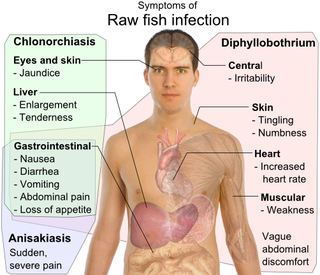
Clonorchiasis is an infectious disease caused by the Chinese liver fluke and two related species. Clonorchiasis is a known risk factor for the development of cholangiocarcinoma, a neoplasm of the biliary system.

Soused herring is raw herring soaked in a mild preserving liquid. It can be raw herring in a mild vinegar pickle or Dutch brined herring. As well as vinegar, the marinade might contain cider, wine or tea, sugar, herbs, spices, and chopped onion.

Anisakis is a genus of parasitic nematodes that have life cycles involving fish and marine mammals. They are infective to humans and cause anisakiasis. People who produce immunoglobulin E in response to this parasite may subsequently have an allergic reaction, including anaphylaxis, after eating fish infected with Anisakis species.

The history of sushi began with paddy fields, where fish was fermented with vinegar, salt and rice, after which the rice was discarded. The earliest form of the dish, today referred to as narezushi, was created in Japan around the Yayoi period. In the Muromachi period (1336–1573), people began to eat the rice as well as the fish. During the Edo period (1603–1867), vinegar rather than fermented rice began to be used. The dish has become a form of food strongly associated with Japanese culture.

A raw bar is a small restaurant or a bar within a restaurant where live shellfish are shucked and served. Raw bars typically offer a variety of raw and cooked seafood and shellfish that is served cold. Seafood-based dishes may also be offered, and additional, non-seafood foods may also be part of the fare. Raw bars may offer alcoholic beverages such as oyster shooters, as well as wine and sake that is paired with various foods. Additional accompaniments may include condiments, sauces and foods such as lemon and lime. Several restaurants in the United States offer raw bars, some of which are seasonal.

Many species of fish are caught by humans and consumed as food in virtually all regions around the world. Fish has been an important dietary source of protein and other nutrients.

Poke is a dish of diced raw fish tossed in sauce and served either as an appetizer or a main course.

Japanese cuisine has a vast array of regional specialities known as kyōdo ryōri (郷土料理) in Japanese, many of them originating from dishes prepared using local ingredients and traditional recipes.
Diphyllobothriasis is the infection caused by tapeworms of the genus Diphyllobothrium.

Like humans and other animals, fish suffer from diseases and parasites. Fish defences against disease are specific and non-specific. Non-specific defences include skin and scales, as well as the mucus layer secreted by the epidermis that traps microorganisms and inhibits their growth. If pathogens breach these defences, fish can develop inflammatory responses that increase the flow of blood to infected areas and deliver white blood cells that attempt to destroy the pathogens.
Raw meat generally refers to any type of uncooked muscle tissue of an animal used for food. In the meat production industry, the term ‘meat’ refers specifically to mammalian flesh, while the words ‘poultry’ and ‘seafood’ are used to differentiate between the tissue of birds and aquatic creatures.

Salmon is a common food fish classified as an oily fish with a rich content of protein and omega-3 fatty acids. Norway is a major producer of farmed and wild salmon, accounting for more than 50% of global salmon production. Farmed and wild salmon differ only slightly in terms of food quality and safety, with farmed salmon having lower content of environmental contaminants, and wild salmon having higher content of omega-3 fatty acids.

Shrimp and prawn are types of sea animals that are consumed worldwide. Although shrimp and prawns belong to different suborders of Decapoda, they are very similar in appearance and the terms are often used interchangeably in commercial farming and wild fisheries. A distinction is drawn in recent aquaculture literature, which increasingly uses the term "prawn" only for the SALT WATER forms of palaemonids and "shrimp" for the marine penaeids. They are the animals most commonly used and killed for food production.

Anisakis simplex, known as the herring worm, is a species of nematode in the genus Anisakis. Like other nematodes, it infects and settles in the organs of marine animals, such as salmon, mackerels and squids. It is commonly found in cold marine waters, such as the Pacific Ocean and Atlantic Ocean.